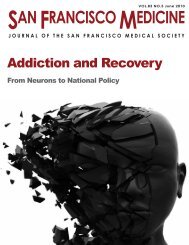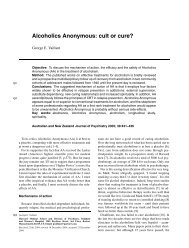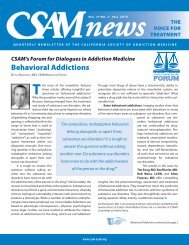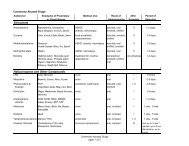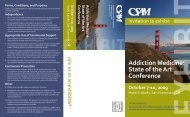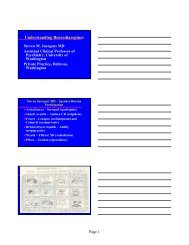CAGE, AUDIT, DAST - California Society of Addiction Medicine
CAGE, AUDIT, DAST - California Society of Addiction Medicine
CAGE, AUDIT, DAST - California Society of Addiction Medicine
You also want an ePaper? Increase the reach of your titles
YUMPU automatically turns print PDFs into web optimized ePapers that Google loves.
8. Why do patients who have only one drink a day screen positive on the<br />
<strong>AUDIT</strong>-C?<br />
The optimal screening thresholds are based on studies that used in-depth interviews to<br />
assess the patient’s drinking and problems due to drinking. These studies found that scores <strong>of</strong> 4<br />
for men (3 for women) were optimal for identifying those with hazardous drinking or active<br />
alcohol use disorders.[5, 6] However, like all screening tests, the <strong>AUDIT</strong>-C does give some<br />
false positives.<br />
A score <strong>of</strong> 4 points for men (3 for women) is used as the threshold for potentially hazardous<br />
drinking. However, when the points are all from question #1 alone (questions #2 & #3 score are<br />
zero), it can be assumed that the patient is drinking below recommended limits. In this situation,<br />
we recommend that the provider review the patient’s alcohol intake over the past few months to<br />
confirm accuracy (e.g. “Has this been your consistent pattern over the past 2-3 months?”),<br />
review the problem list to ensure there are no medical contraindications due to drinking (e.g.<br />
hepatitis C, prior alcohol treatment), and advise the patient to stay below recommended limits.<br />
Recommended limits:<br />
Men: No more than 14 drinks a week, 4 drinks per occasion<br />
Women: No more than 7 drinks a week, 3 drinks per occasion<br />
9. Will the <strong>AUDIT</strong>-C miss alcohol dependence?<br />
In validation studies that compared the <strong>AUDIT</strong>-C to in-depth interviews, the <strong>AUDIT</strong>-C<br />
was as good as the <strong>CAGE</strong> Questionnaire for identifying male patients with active alcohol abuse<br />
or dependence.[2, 5] It was also an effective screening test for active alcohol abuse or<br />
dependence in women [6] and more effective than the TWEAK (an adaptation <strong>of</strong> the <strong>CAGE</strong> for<br />
women). [7]<br />
10. Why is the <strong>AUDIT</strong>-C cut-<strong>of</strong>f higher for men than women?<br />
The recommended cut-<strong>of</strong>f for women is based on a study <strong>of</strong> female VA patients, which<br />
used in-depth interviews to assess their drinking patterns and problems due to drinking.[6]<br />
Women develop problems due to drinking at lower levels <strong>of</strong> alcohol consumption than men.<br />
This reflects their lower total body water as well as possible differences in metabolism. Alcohol<br />
use is also more stigmatized for women compared to men, so women may be more likely to<br />
under-report their drinking.<br />
Recommended Limits: [1]<br />
PREVENTIVE ADVICE<br />
Men: No more than 14 drinks a week, and 4 drinks Advise on any patient single to occasion stay below<br />
Women: No more than 7 drinks a week, and 3 drinks recommended on any single limits occasion<br />
What is SBIRT? How Do You Do It and Teach It Effectively?<br />
October 7, 2009 / Hotel Kabuki, San Francisco<br />
Resident and Faculty Education <strong>of</strong>fered by the<br />
Medical Education and Research Foundation for the Treatment <strong>of</strong> Alcoholism and Other Drug Dependencies (MERF)<br />
and the <strong>California</strong> <strong>Society</strong> <strong>of</strong> <strong>Addiction</strong> <strong>Medicine</strong> (CSAM)





